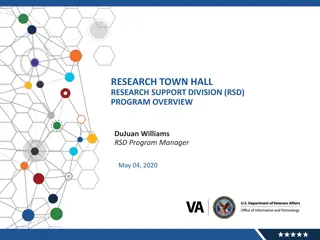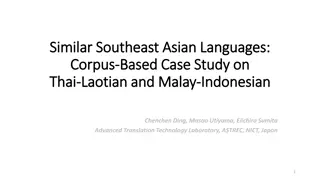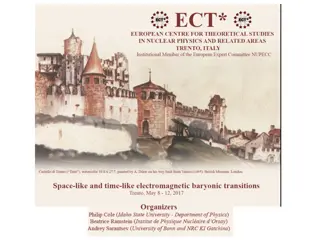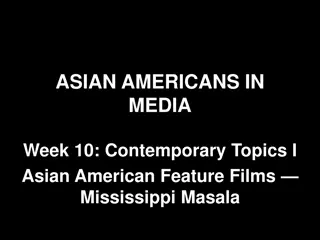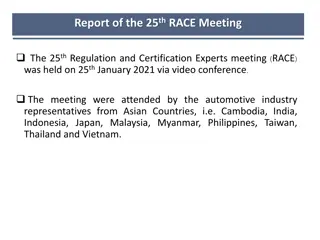Providing Research Support for Asian Studies: Tools and Programs
The presentation explores the development of Asian Studies in North America and the tools and programs available to support undergraduate research incorporating Asian languages. Librarians work with students to navigate resources in Asian languages, offering guidance on conducting research and accessing materials. Examples include LibGuides, research guides, and finding aids on specific databases and collections.
Download Presentation

Please find below an Image/Link to download the presentation.
The content on the website is provided AS IS for your information and personal use only. It may not be sold, licensed, or shared on other websites without obtaining consent from the author.If you encounter any issues during the download, it is possible that the publisher has removed the file from their server.
You are allowed to download the files provided on this website for personal or commercial use, subject to the condition that they are used lawfully. All files are the property of their respective owners.
The content on the website is provided AS IS for your information and personal use only. It may not be sold, licensed, or shared on other websites without obtaining consent from the author.
E N D
Presentation Transcript
Panel: Panel: Librarianship in a changing world: Providing research support for Asian Studies Librarianship in a changing world: Providing research support for Asian Studies Hana Kim University of British Columbia AAS-in-Asia Conference | Academia Sinica, Taiwan | June 23, 2015
The development of Asian Studies in North America created the language material. the need need for for undergraduate undergraduate to use of Asian It is important for the students to learn how to find and use materials in Asian languages, even if they have only a limited language capability. Asian Studies librarians and/or faculty have developed programs and/or tools to support undergraduate research incorporating Asian languages. Examples of the tools and programs will be introduced in this presentation.
Interviewed various librarians and faculty in the field of Asian Studies University of British Columbia University of Toronto University of Alberta University of Calgary McGill University Simon Fraser University University of Victoria York University University of British Columbia University of Toronto
Although the bulk of librarians work is targeted at graduate students and faculty who are able to use collections in original script, librarians introduce more sessions librarians meet introduce some more accessible sessions. . meet with some of accessible through with undergraduate of the through general undergraduate students the tools general consultation students to they may consultation to tools they may find find
All classes are given guidance on how to conduct research in a targeted language more generally, Romanization and how that can impact a search. considering differences in
LibGuides/Research Guides & Finding Aids on specific databases/collections /courses.
Guides from U of Toronto
Guides from U of Toronto
Building good reads or extensive reading collections to encourage students to improve Asian language reading at the undergraduate level It will help with reading comprehension, vocabulary, writing, and understanding Asian languages. Non-fiction Fiction Graded Readers Children s picture books Textbooks for studying Asian languages Comics/Manga/Manhwa
Films/Documentaries/TV Series (most of universities) Games (U of British Columbia) Nintendo DS video games
Programs are more designed for advanced students: 3XX-, 4XX-level courses Specialist (U of Toronto)
Course To help students move toward the literary besides just trying to acquire language skills in normal class learning environment. Course Objectives Objectives: : the appreciation the pleasure appreciation of pleasure of of literary works works and discover discover the of reading reading To provide students an opportunity to practice how to to all the W questions regarding the work that students have read. how to write write a a succinct succinct summary summary that includes answers
Assignment: Students have the freedom to choose any material Assignment: Students choose something that is of interest to them Short stories Graded readers Folklores and fairy tales Students submit a summary (400-800 words) after reading.
Term Project No.1: Choose a topic that students are interested in. Report to the instructor of topic & get permission. Look for materials pertinent to the topic of interest using library search systems: 1 in Japanese (at least 1 must be from the Asian Library resource) and 1 in English Read all the materials. Summarize main points and provide analysis & opinions (1500- 2000 words). Make a 5 min. presentation at the end of term. Librarian teaches plagiarism and citation styles.
Term To (historic/current) figure or incident that has an impact on Japanese people and culture from a cultural history perspective. To using To practice summarizing/translating materials written in English to Japanese. To improve students proficiency while learning content matter through self-learning. Term Project Project No conduct No. .2 2: : research on a famous To practice using relevant practice reading relevant library reading authentic library resources authentic Japanese resources and Japanese materials and study materials study tools tools. .
Procedures: Choose an era. Consult the table History Look for materials using library search systems (information session offered by Japanese language librarian) Required number of articles (minimum): 2 in 1 in English Summarize the main points (1,600 provide analysis and opinions. Make a 5 minute presentation. Procedures: Choose an era. Consult the table History . . /Japanese Cultural /Japanese Cultural 2 in Japanese Japanese (at least one must be from the Asian Library) (1,600- -2,000 words) 2,000 words) and
The Character Tool is not a research tool, but it is a language learning tool. Source: http://news.ubc.ca/2012/05/10/want-to- learn-chinese-characters-ubc-has-an-app- for-that/
Research-intensive course Students in this class are expected to make use of the primary sources. Limitation: Most students rely on using primary sources in translation. Note: Even students who are familiar with modern Chinese are often unable to handle classical Chinese.
The project is designed to engage students of Punjabi at UBC in the collection of oral histories within the Punjabi Canadian community of greater Vancouver. 400-level Punjabi Oral Histories (in the past 300-level Punjabi) 400-level Documenting Punjabi Canada
Offers students the opportunity to write a senior thesis. Students work on their own research projects with the goal of completing a polished, original research paper of 25-30 pages. The first semester focuses on research methodology, while the second half is conducted as a writing course, focusing on writing, rewriting, editing and peer review.
I. East I. East Asian Asian Studies Studies collections tour collections tour (Both English and East Asian language scripts) II. General Library Research 1. How to find books and journals in OPAC 2. Principles of information literacy--guidelines on how to search efficiently and how to identify useful resources (including CJK examples) 3. Important general EAS English language e-resources: Bibliography of Asian Studies, Scholars Portal, Google scholar. (include CJK examples) 4. How to prepare bibliography, referencing with examples of referencing styles, and use of Refworks/EndNote to facilitate research and writing II. General Library Research S Session ession: 2 hours class time in computer lab III. separate locations in the East Asian library 1. Romanization systems and how to use 2. Selective important subject resources: -Important English and CJK e-resources and how to search -Important print resources and how to search III. Subject Subject Focus Focus L Library Research Session ibrary Research Session, with CJK sessions to be held concurrently in IV. . Individual follow Individual follow- -up research up research consultations in using students research topics consultations in using students research topics
Two institutions having a major Asian Studies program and Asian collections seem to offer more diverse guides and tools. Handled in an ad-hoc, localized way without any centralized oversight and certainly not with any pool of pre-existing teaching resources or materials.
Faculty-Librarian partnership and collaboration can lead to a even-greater success of student learning.
McGill U Macy Zheng Simon Fraser U Dr. Paul Crowe U of Toronto Lucy Gan Fabiano Rocha Dr. Kyoungrok Ko York U Haiyun Cao U of Alberta Louis Chor Mengjia Zhang U of British Columbia Dr. Rebecca Chau Dr. Ross King Dr. Leo Shin Shirin Eshghi Jing Liu Sarbjit Randhawa U of Calgary










